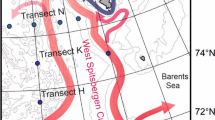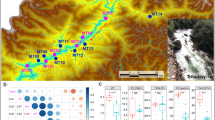Abstract
Mangrove sediments are anaerobic ecosystems rich in organic matter. This environment is optimal for anaerobic microorganisms, such as sulphate-reducing bacteria and methanogenic archaea, which are responsible for nutrient cycling. In this study, the diversity of these two functional guilds was evaluated in a pristine mangrove forest using denaturing gradient gel electrophoresis (DGGE) and clone library sequencing in a 50 cm vertical profile sampled every 5.0 cm. DGGE profiles indicated that both groups presented higher richness in shallow samples (0–30 cm) with a steep decrease in richness beyond that depth. According to redundancy analysis, this alteration significantly correlated with a decrease in the amount of organic matter. Clone library sequencing indicated that depth had a strong effect on the selection of dissimilatory sulphate reductase (dsrB) operational taxonomic units (OTUs), as indicated by the small number of shared OTUs found in shallow (0.0 cm) and deep (40.0 cm) libraries. On the other hand, methyl coenzyme-M reductase (mcrA) libraries indicated that most of the OTUs found in the shallow library were present in the deep library. These results show that these two guilds co-exist in these mangrove sediments and indicate important roles for these organisms in nutrient cycling within this ecosystem.







Similar content being viewed by others
References
Andreote FD, Azevedo JL, Araujo WL (2009) Assessing the diversity of bacterial communities associated with plants. Braz J Microbiol 40:417–432
Bagwell CE, Formolo M, Ye Q, Yeager CM, Lyons TW, Zhang CL (2009) Direct analysis of sulfate reducing bacterial communities in gas hydrate-impacted marine sediments by PCR-DGGE. J Basic Microbiol 49:S87–92
Bahr M, Crump BC, Klepac-Ceraj V, Teske A, Sogin ML, Hobbie JE (2005) Molecular characterization of sulfate-reducing bacteria in a New England salt marsh. Environ Microbiol 7:1175–1185
Boetius A (2005) Microfauna-macrofauna interaction in the seafloor: lessons from the tubeworm. PLoS Biol 3:e102
Cole JR, Wang Q, Cardenas E, Fish J, Chai B, Farris RJ et al (2009) The Ribosomal Database Project: improved alignments and new tools for rRNA analysis. Nucleic Acids Res 37:D141–145
Dar SA, Yao L, van Dongen U, Kuenen JG, Muyzer G (2007) Analysis of diversity and activity of sulfate-reducing bacterial communities in sulfidogenic bioreactors using 16S rRNA and dsrB genes as molecular markers. Appl Environ Microbiol 73:594–604
Dar SA, Kleerebezem R, Stams AJM, Kuenen JG, Muyzer G (2008) Competition and coexistence of sulfate-reducing bacteria, acetogens and methanogens in a lab-scale anaerobic bioreactor as affected by changing substrate to sulfate ratio. Appl Environ Microbiol 78:1045–1055
DeSantis TZ, Hugenholtz P, Larsen N, Rojas M, Brodie EL, Keller K et al (2006) Greengenes, a chimera-checked 16S rRNA gene database and workbench compatible with ARB. Appl Environ Microbiol 72:5069–5072
Foti M, Sorokin DY, Lomans B, Mussman M, Zacharova EE, Pimenov NV et al (2007) Diversity, activity, and abundance of sulfate-reducing bacteria in saline and hypersaline soda lakes. Appl Environ Microbiol 73:2093–2100
Geets J, Borremans B, Diels L, Springael D, Vangronsveld J, van der Lelie D, Vanbroekhoven K (2006) DsrB gene-based DGGE for community and diversity surveys of sulfate-reducing bacteria. J Microbiol Methods 66:194–205
Goffredi SK, Wilpiszeski R, Lee R, Orphan VJ (2008) Temporal evolution of methane cycling and phylogenetic diversity of archaea in sediments from a deep-sea whale-fall in Monterey Canyon, California. ISME J 2:204–220
Harrison BK, Zhang H, Berelson W, Orphan VJ (2009) Variations in archaeal and bacterial diversity associated with the sulfate-methane transition zone in continental margin sediments (Santa Barbara Basin, California). Appl Environ Microbiol 75:1487–1499
Holguin G, Vazquez P, Bashan Y (2001) The role of sediment microorganisms in the productivity, conservation, and rehabilitation of mangrove ecosystems: an overview. Biol Fert Soils 33:265–278
Liang JB, Chen YQ, Lan CY, Tam NFY, Zan QJ, Huang LN (2007) Recovery of novel bacterial diversity from mangrove sediment. Mar Biol 150:739–747
Ludwig W, Strunk O, Westram R, Richter L, Meier H, Yadhukumar et al (2004) ARB: a software environment for sequence data. Nucleic Acids Res 32:1363–1371
Luton PE, Wayne JM, Sharp RJ, Riley PW (2002) The mcrA gene as an alternative to 16S rRNA in the phylogenetic analysis of methanogen populations in landfill. Microbiology (Sgm) 148:3521–3530
Lyimo TJ, Pol A, Op den Camp HJ (2002) Sulfate reduction and methanogenesis in sediments of Mtoni mangrove forest, Tanzania. Ambio 31:614–616
Lyimo TJ, Pol A, Jetten MS, den Camp HJ (2009) Diversity of methanogenic archaea in a mangrove sediment and isolation of a new Methanococcoides strain. FEMS Microbiol Lett 291:247–253
Madigan MT, Martinko JM, Parker J (2003) Brock biology of microorganisms. Pearson Education Inc, Saddle River, NJ
Miralles G, Grossi V, Acquaviva M, Duran R, Bertrand JC, Cuny P (2007) Alkane biodegradation and dynamics of phylogenetic subgroups of sulfate-reducing bacteria in an anoxic coastal marine sediment artificially contaminated with oil. Chemosphere 68:1327–1334
Muyzer G, Stams AJM (2008) The ecology and biotechnology of sulphate-reducing bacteria. Nat Rev Microbiol 6:441–454
Muyzer G, Dewaal EC, Uitterlinden AG (1993) Profiling of complex microbial-populations by denaturing gradient gel-electrophoresis analysis of polymerase chain reaction-amplified genes-coding for 16s ribosomal-RNA. Appl Environ Microbiol 59:695–700
Oremland RS, Marsh LM, Polcin S (1982) Methane production and simultaneous sulfate reduction in anoxic, salt-marsh sediments. Nature 296:143–145
Orphan VJ, House CH, Hinrichs KU, McKeegan KD, DeLong EF (2002) Multiple archaeal groups mediate methane oxidation in anoxic cold seep sediments. Proc Natl Acad Sci USA 99:7663–7668
Orphan VJ, Jahnke LL, Embaye T, Turk KA, Pernthaler A, Summons RE, Des Marais DJ (2008) Characterization and spatial distribution of methanogens and methanogenic biosignatures in hypersaline microbial mats of Baja California. Geobiology 6:376–393
Parkes RJ, Webster G, Cragg BA, Weightman AJ, Newberry CJ, Ferdelman TG et al (2005) Deep sub-seafloor prokaryotes stimulated at interfaces over geological time. Nature 436:390–394
Parkes RJ, Cragg BA, Banning N, Brock F, Webster G, Fry JC et al (2007) Biogeochemistry and biodiversity of methane cycling in subsurface marine sediments (Skagerrak, Denmark). Environ Microbiol 9:1146–1161
Schloss PD, Westcott SL, Ryabin T, Hall JR, Hartmann M, Hollister EB et al (2009) Introducing mothur: open-source, platform-independent, community-supported software for describing and comparing microbial communities. Appl Environ Microbiol 75:7537–7541
Taketani RG, dos Santos HF, van Elsas JD, Rosado AS (2009) Characterisation of the effect of a simulated hydrocarbon spill on diazotrophs in mangrove sediment mesocosm. Antonie van Leeuwenhoek 96:343–354
Taketani RG, Franco NO, Rosado AS, van Elsas JD (2010) Microbial community response to a simulated hydrocarbon spill in mangrove sediments. J Microbiol 48. doi:10.1007/s12275-009-0147-1
Thomsen TR, Finster K, Ramsing NB (2001) Biogeochemical and molecular signatures of anaerobic methane oxidation in a marine sediment. Appl Environ Microbiol 67:1646–1656
Wilms R, Sass H, Kopke B, Koster J, Cypionka H, Engelen B (2006a) Specific bacterial, archaeal, and eukaryotic communities in tidal-flat sediments along a vertical profile of several meters. Appl Environ Microbiol 72:2756–2764
Wilms R, Kopke B, Sass H, Chang TS, Cypionka H, Engelen B (2006b) Deep biosphere-related bacteria within the subsurface of tidal flat sediments. Environ Microbiol 8:709–719
Wilms R, Sass H, Kopke B, Cypionka H, Engelen B (2007) Methane and sulfate profiles within the subsurface of a tidal flat are reflected by the distribution of sulfate-reducing bacteria and methanogenic archaea. FEMS Microbiol Ecol 59:611–621
Yan B, Hong K, Yu ZN (2006) Archaeal communities in mangrove soil characterized by 16S rRNA gene clones. J Microbiol 44:566–571
Acknowledgements
The authors sincerely express their thanks and gratitude to CNPq—Conselho Nacional de Pesquisa e Desenvolvimento Tecnológico and FAPESP—Fundação de Amparo à Pesquisa do Estado de São Paulo for the financial support of the projects No. 474455/2007-6 and No. 2006/06700-0, respectively. We also would like to thank the fellowships given by: (a) CNPq to R.G. Taketani, Caio Yoshiura and S.M.Tsai (PQ), and (b) FAPESP to F. D. Andreote and A.C.F. Dias.
Author information
Authors and Affiliations
Corresponding author
Rights and permissions
About this article
Cite this article
Taketani, R.G., Yoshiura, C.A., Dias, A.C.F. et al. Diversity and identification of methanogenic archaea and sulphate-reducing bacteria in sediments from a pristine tropical mangrove. Antonie van Leeuwenhoek 97, 401–411 (2010). https://doi.org/10.1007/s10482-010-9422-8
Received:
Accepted:
Published:
Issue Date:
DOI: https://doi.org/10.1007/s10482-010-9422-8




